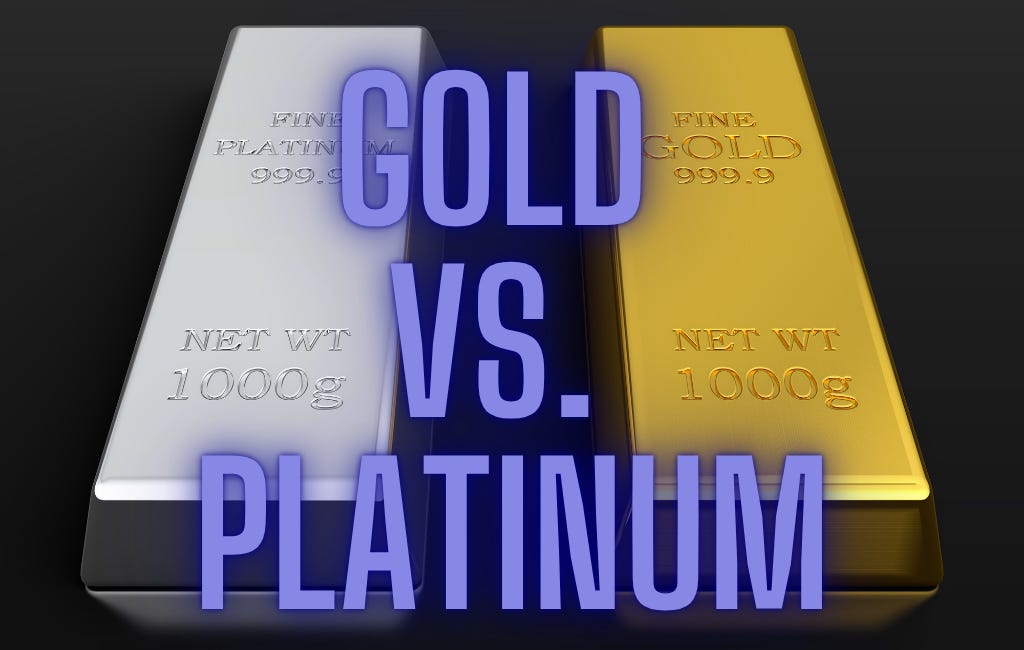Gold and platinum remain two of the most closely watched precious metals in global markets, each offering distinct investment characteristics. While gold maintains its reputation as the ultimate safe-haven asset, platinum continues to attract investors with its rarity and heavy industrial usage. Understanding their 2025 price behavior, market dynamics, and key advantages and drawbacks can help investors tailor their strategies based on risk tolerance and financial goals.
At a Glance: Gold vs. Platinum in 2025
>>> Click here to learn more about Gold vs. Platinum <<<
2025 Market Snapshot: Platinum vs. Gold Prices
As of April 2025, gold (XAUUSD) is trading around $2,320 per ounce, after pulling back slightly from its early-year highs of $2,415 in February. Meanwhile, platinum (XPTUSD) is priced near $970 per ounce, showing modest recovery from its 2024 lows but still well below its historical highs.
Persistent geopolitical tensions, inflationary concerns, and global central bank buying have driven gold's momentum. Platinum, although still in demand for industrial applications—especially in hydrogen fuel cell technology and automotive sectors—remains more volatile due to fluctuating economic conditions.
Price History Comparison: Gold and Platinum
Gold’s Price Journey
Gold's performance in recent years has been robust. After opening 2024 at about $2,060, it surged to an all-time high above $2,480 by mid-2024, driven largely by geopolitical unrest and inflation fears. Although prices moderated slightly in early 2025, gold remains in a strong uptrend supported by resilient central bank demand, including from emerging markets like India and China.
In the broader timeline:
2023: Gold ranged between $1,900 - $2,150, reflecting high inflation and fluctuating rate expectations.
2022: It moved between $1,750 - $2,000, buoyed by rate hikes and economic uncertainty.
Pandemic Era: Gold peaked near $2,070 in 2020 and maintained a strong floor above $1,700 throughout subsequent years.
Platinum Price Fluctuations Through the Years
Platinum has had a rockier ride:
After starting 2024 around $960 platinum saw a mid-year rally to $1,040 before retreating below $900 later that year due to weakening automotive demand and global recession fears.
In 2025, platinum prices have stabilized near $970, supported by growing investment in hydrogen technologies and stricter emissions standards requiring platinum-heavy catalytic converters.
Long-term trends show platinum declining from over $1,200 in early 2021 to current levels, highlighting the metal's industrial sensitivity.
Weighing the Pros and Cons: Trading Gold vs. Platinum
Platinum Trading: Strengths and Weaknesses
Advantages:
Rarity and Strategic Importance: Platinum remains much rarer than gold, enhancing its strategic value, especially for the clean energy transition (hydrogen economy).
Industrial Demand: Increased use in automotive, chemical, and fuel cell sectors can create strong upside opportunities.
Inflation Hedge: Like gold, platinum offers some protection against inflation and currency debasement.
Disadvantages:
High Volatility: Platinum's heavy reliance on industrial demand makes it more susceptible to economic cycles and sector-specific disruptions.
Lower Liquidity: Compared to gold, platinum markets have thinner liquidity, potentially leading to wider spreads and increased transaction costs.
Economic Sensitivity: Global slowdowns or sector-specific downturns (like the EV transition reducing internal combustion engine demand) can pressure prices.
Gold Trading: Benefits and Drawbacks
Advantages:
Safe-Haven Asset: Gold remains the go-to store of value during financial crises, wars, and monetary instability.
High Liquidity: Gold markets are deep, liquid, and globally accessible, ensuring low trading friction.
Central Bank Support: Consistent buying from central banks worldwide further underpins gold’s value.
Disadvantages:
Storage and Insurance Costs: Physical gold ownership involves ongoing security and storage expenses.
No Yield Generation: Gold doesn’t pay dividends or interest, meaning all returns rely on capital appreciation.
Potential Overvaluation Risks: Periods of rapid price rises can make gold vulnerable to sharp corrections when macro conditions shift.
Final Thoughts
Both gold and platinum play valuable but different roles in a diversified portfolio. Gold is still the clear choice for stability, long-term wealth preservation, and crisis hedging. Platinum offers unique upside potential tied to industrial growth and new technologies, albeit with higher volatility and cyclical risks.
Investors should choose based on their risk appetite, time horizon, and broader economic outlook:
Conservative investors might lean heavily toward gold.
Growth-seeking or opportunistic investors might allocate a portion toward platinum to capture potential industrial demand booms, especially from hydrogen and automotive sectors.
Remaining informed and responsive to market trends is critical to optimizing precious metals strategies in 2025 and beyond.
Investors looking to diversify their portfolios with precious metals may consider evaluating reputable platforms, brokerage firms, or investment funds that specialize in gold and platinum assets. Comparing different options based on fees, storage solutions, and accessibility can help tailor the right approach for long-term financial goals. Staying updated with market developments and consulting with financial advisors is key to making informed investment decisions in 2025 and beyond.
>>> Click here to learn more about Gold vs. Platinum <<<
Frequently Asked Questions (FAQs)
1. Is platinum more valuable than gold in 2025?
No. Despite platinum's greater rarity, gold continues to command a higher market price due to its unmatched demand as a safe-haven and monetary asset.
2. Which metal is better during a recession?
Gold remains the favored asset during recessions, offering reliability when industrial demand for platinum tends to decline.
3. Can I invest in both gold and platinum?
Absolutely. Diversifying across both can balance the safety of gold with the growth potential of platinum, enhancing risk-adjusted returns.
4. Why is platinum more volatile than gold?
Platinum prices react strongly to shifts in industrial demand (especially in automotive and hydrogen industries), making them more cyclical than gold.
5. Do gold or platinum pay income like stocks or bonds?
No. Both are non-yielding assets, meaning they generate returns solely through price appreciation.





